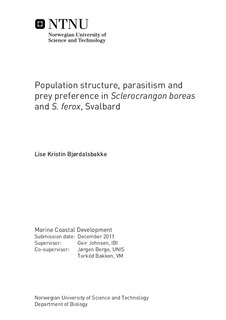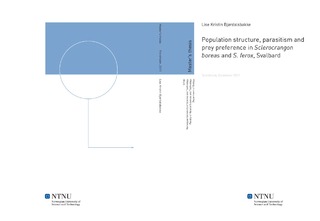| dc.contributor.advisor | Johnsen, Geir | nb_NO |
| dc.contributor.advisor | Berge, Jørgen | nb_NO |
| dc.contributor.advisor | Bakken, Torkild | nb_NO |
| dc.contributor.author | Bjørdalsbakke, Lise Kristin | nb_NO |
| dc.date.accessioned | 2014-12-19T13:14:43Z | |
| dc.date.available | 2014-12-19T13:14:43Z | |
| dc.date.created | 2012-02-02 | nb_NO |
| dc.date.issued | 2011 | nb_NO |
| dc.identifier | 489239 | nb_NO |
| dc.identifier | ntnudaim:6598 | nb_NO |
| dc.identifier.uri | http://hdl.handle.net/11250/245779 | |
| dc.description.abstract | The aim of this study was to enhance the knowledge on ecological and life-history parameters of Sclerocrangon boreas and Sclerocrangon ferox in Svalbard waters, including sex ratio, population structure, parasitism and prey preference. Little research has been done on S. ferox before. It has been subject to unprecedented research in the present study, considering size distribution, prey preference and DNA barcoding. The barcoding result gave a genetic distance of 13.7 % between S. boreas and S. ferox. This study shows a clear difference in size distribution between males and females. Females are considerably larger than the males. This is an indication of the two species being protandric hermaphrodite. These findings support earlier research, showing the same pattern, suggesting S. boreas being a protandric hermaphrodite. It has not been found studies looking on S. ferox considering this, but the present study shows also this species follow this pattern and are most likely protandric hermaphrodite. The largest groups of prey found in the stomach content were Crustacea, Echinoidea and Ophiuroidea. Individual specimens had mostly one type of prey in their stomach, but several types of prey were identified for both species. These findings suggest that S. boreas and S. ferox are specialists as individual specimens and generalists as species. The genetic results indicate that the specimens of S. boreas from Smeerenburg are distinguished from Grønfjorden and Rijpfjorden, and there were also variation within the specimens sampled in Smeerenburg. However, the results do not give a basis to conclude whether the populations have different genetic signatures between the fjords where S. boreas is found. It can be concluded that DNA barcoding and the CO1 gene do not together give ample information of genetic differences within populations, but it will still be able to give a genetic signal on differences between populations. Parasites were found on both S. boreas and on S. ferox. Genetic analyses, using CO1 and 18S, of the parasites conclude that they are cocoons from a piscicolid (fish) leech. The identity of this species has not been found. | nb_NO |
| dc.language | eng | nb_NO |
| dc.publisher | Institutt for biologi | nb_NO |
| dc.subject | ntnudaim:6598 | no_NO |
| dc.subject | MSMACODEV Marine Coastal Development | no_NO |
| dc.subject | Marine Biology and Biochemistry | no_NO |
| dc.title | Population structure, parasitism and prey preference in Sclerocrangon boreas and S. ferox, Svalbard | nb_NO |
| dc.type | Master thesis | nb_NO |
| dc.source.pagenumber | 41 | nb_NO |
| dc.contributor.department | Norges teknisk-naturvitenskapelige universitet, Fakultet for naturvitenskap og teknologi, Institutt for bioteknologi | nb_NO |

